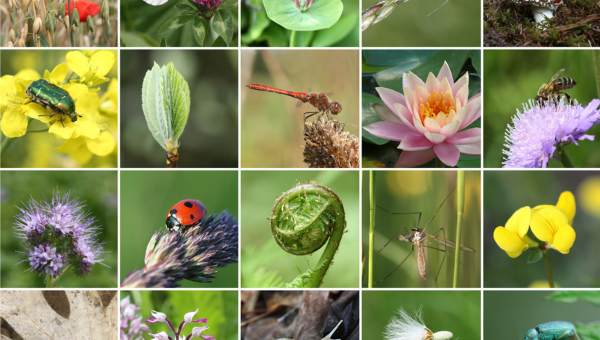Confronting Dramatic Biodiversity Loss on 50th Anniversary of Endangered Species Act – Beyond Pesticides Daily News Blog
Confronting Dramatic Biodiversity Loss on 50th Anniversary of ... Beyond Pesticides


On the 50th anniversary of the Endangered Species Act, EPA’s ability to evaluate pesticides for their impact on threatened and endangered species is questioned

Introduction
The U.S. Environmental Protection Agency (EPA) is facing concerns about its ability to evaluate pesticides for their adverse impact on threatened and endangered species on the 50th anniversary of the Endangered Species Act (ESA). Despite efforts to address a significant backlog of pesticide evaluations, the EPA acknowledges that it may take several additional decades to fully catch up, representing only 5 percent of its ESA obligations.
Sustainable Development Goals (SDGs)
As part of a “whole of government” approach, it is crucial for the EPA to redirect its pesticide program to protect all species and their habitats. This aligns with the following Sustainable Development Goals:
- Goal 14: Life Below Water – Protect and restore marine ecosystems and promote sustainable use of marine resources.
- Goal 15: Life on Land – Protect, restore, and promote sustainable use of terrestrial ecosystems, sustainably manage forests, combat desertification, halt and reverse land degradation, and halt biodiversity loss.
The Crisis of Biodiversity Loss
The speed and depth of biodiversity loss have reached crisis proportions. The Intergovernmental Science-Policy Platform on Biodiversity and Ecosystem Services (IPBES) highlighted the decline in regulating and non-material contributions of nature, including soil organic carbon and pollinator diversity. The loss of biodiversity has significant implications for human well-being and the global economy.
The ESA has played a pivotal role in preventing extinctions and protecting critically endangered species. However, to address the broader issue of biodiversity loss, the ESA aims to conserve ecosystems and take appropriate steps to achieve the purposes of international treaties and conventions.
Pesticides and Biodiversity Loss
Pesticide use is a major cause of declining biodiversity, leading to extinctions, endangered species, and vulnerability to environmental disturbances. Studies have shown that pesticides, particularly in combination with climate change, contribute to the loss of insect biomass and diversity. Insects play a crucial role as pollinators and in supporting the food web, making their decline a threat to life on Earth.
EPA’s registration of insecticides, from DDT to neonicotinoids, has endangered insects globally. Pesticides also pose threats to frogs, amphibians, and other animals, affecting their growth and reproduction. Agricultural intensification, driven by pesticide and fertilizer use, is a leading factor in bird population declines.
The Role of EPA in Protecting Endangered Species
EPA’s approval of pesticides that eliminate habitat through destruction or toxic contamination contributes to the endangerment of species. Industrial agriculture, characterized by bare fields for half the year and monoculture practices, contrasts with organic agriculture that promotes biodiversity conservation.
To truly protect endangered species, EPA must eliminate the use of toxic pesticides and consider organic production. This aligns with the Federal Insecticide, Fungicide, and Rodenticide Act (FIFRA), which prohibits unreasonable adverse effects on the environment.
Call for Action
A coalition of environmental organizations, including Beyond Pesticides, has sent an urgent letter to President Joe Biden, calling for comprehensive action to preserve biodiversity. The letter emphasizes the need for a whole-of-government approach, adequate funding for the ESA, and the adoption of an ecosystem-based framework to recover endangered species and rebuild wildlife populations.
In line with this approach, EPA must redirect its pesticide program to protect all species and their habitats. By eliminating the registrations of toxic pesticides and promoting organic production, EPA can contribute to safeguarding biodiversity and fulfilling its obligations under the ESA.
SDGs, Targets, and Indicators
1. Which SDGs are addressed or connected to the issues highlighted in the article?
- SDG 15: Life on Land
- SDG 13: Climate Action
- SDG 12: Responsible Consumption and Production
- SDG 14: Life Below Water
The issues highlighted in the article include declining biodiversity, endangered species, habitat degradation, climate change, and the impact of pesticides on ecosystems. These issues are directly connected to SDG 15 (Life on Land), which aims to protect, restore, and promote sustainable use of terrestrial ecosystems. The article also mentions the impact of pesticides on aquatic and marine environments, which relates to SDG 14 (Life Below Water). Additionally, the article highlights the need for organic regenerative and agroecological systems, which align with SDG 12 (Responsible Consumption and Production) and SDG 13 (Climate Action) in promoting sustainable agricultural practices.
2. What specific targets under those SDGs can be identified based on the article’s content?
- Target 15.5: Take urgent and significant action to reduce the degradation of natural habitats
- Target 15.9: By 2020, integrate ecosystem and biodiversity values into national and local planning, development processes, poverty reduction strategies, and accounts
- Target 12.4: By 2020, achieve the environmentally sound management of chemicals and all wastes throughout their life cycle, in accordance with agreed international frameworks, and significantly reduce their release to air, water, and soil to minimize their adverse impacts on human health and the environment
- Target 14.2: By 2020, sustainably manage and protect marine and coastal ecosystems to avoid significant adverse impacts, including by strengthening their resilience, and take action for their restoration in order to achieve healthy and productive oceans
Based on the article’s content, the specific targets that can be identified include reducing habitat degradation (Target 15.5), integrating ecosystem and biodiversity values into planning and development processes (Target 15.9), achieving environmentally sound management of chemicals (Target 12.4), and sustainably managing and protecting marine and coastal ecosystems (Target 14.2).
3. Are there any indicators mentioned or implied in the article that can be used to measure progress towards the identified targets?
- Indicator 15.5.1: Red List Index
- Indicator 15.9.1: Progress towards national targets established in accordance with Aichi Biodiversity Target 2 of the Strategic Plan for Biodiversity 2011-2020
- Indicator 12.4.1: Number of parties to international multilateral environmental agreements on hazardous waste, including their compliance with the agreements
- Indicator 14.2.1: Proportion of national exclusive economic zones managed using ecosystem-based approaches
The article does not explicitly mention specific indicators, but based on the identified targets, the following indicators can be used to measure progress: the Red List Index (Indicator 15.5.1) to assess the conservation status of species, progress towards national targets for biodiversity (Indicator 15.9.1), the number of parties to international agreements on hazardous waste (Indicator 12.4.1), and the proportion of national exclusive economic zones managed using ecosystem-based approaches (Indicator 14.2.1).
SDGs, Targets, and Indicators
| SDGs | Targets | Indicators |
|---|---|---|
| SDG 15: Life on Land | Target 15.5: Take urgent and significant action to reduce the degradation of natural habitats | Indicator 15.5.1: Red List Index |
| SDG 15: Life on Land | Target 15.9: By 2020, integrate ecosystem and biodiversity values into national and local planning, development processes, poverty reduction strategies, and accounts | Indicator 15.9.1: Progress towards national targets established in accordance with Aichi Biodiversity Target 2 of the Strategic Plan for Biodiversity 2011-2020 |
| SDG 12: Responsible Consumption and Production | Target 12.4: By 2020, achieve the environmentally sound management of chemicals and all wastes throughout their life cycle, in accordance with agreed international frameworks, and significantly reduce their release to air, water, and soil to minimize their adverse impacts on human health and the environment | Indicator 12.4.1: Number of parties to international multilateral environmental agreements on hazardous waste, including their compliance with the agreements |
| SDG 14: Life Below Water | Target 14.2: By 2020, sustainably manage and protect marine and coastal ecosystems to avoid significant adverse impacts, including by strengthening their resilience, and take action for their restoration in order to achieve healthy and productive oceans | Indicator 14.2.1: Proportion of national exclusive economic zones managed using ecosystem-based approaches |
Behold! This splendid article springs forth from the wellspring of knowledge, shaped by a wondrous proprietary AI technology that delved into a vast ocean of data, illuminating the path towards the Sustainable Development Goals. Remember that all rights are reserved by SDG Investors LLC, empowering us to champion progress together.
Source: beyondpesticides.org

Join us, as fellow seekers of change, on a transformative journey at https://sdgtalks.ai/welcome, where you can become a member and actively contribute to shaping a brighter future.







